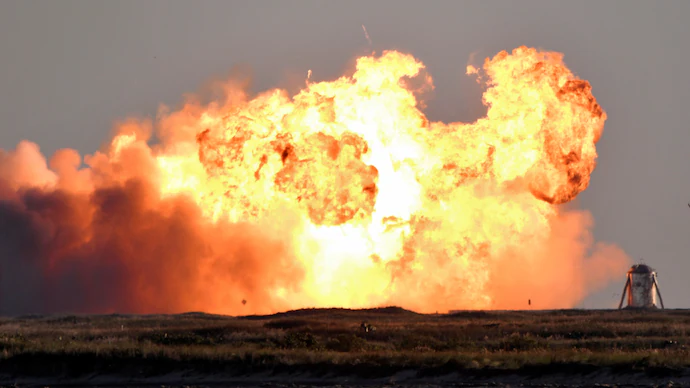SpaceX’s aspirations for the next phase of its Starship program were abruptly derailed late Wednesday night after a dramatic explosion rocked its Starbase testing facility in Texas. The incident, which occurred during a static fire test of the vehicle known as Ship 36, has resulted in substantial damage to the prototype and indefinite delays to the company’s launch schedule.
The blast unfolded just before midnight during what was intended to be a routine engine ignition while the spacecraft was secured on the ground—a procedure meant to simulate launch conditions. Video shared online showed a fiery detonation erupting from the base of the rocket, sending flames and debris across the site. Fortunately, no injuries were reported.
In a public statement posted to X, SpaceX confirmed:
“On Wednesday, June 18 at approximately 11 p.m. CT, the Starship preparing for the tenth flight test experienced a major anomaly while on a test stand at Starbase.”
Officials emphasised that safety protocols were followed throughout the test:
“A safety clear area around the site was maintained throughout the operation and all personnel are safe and accounted for. Our Starbase team is actively working to safe the test site and the immediate surrounding area in conjunction with local officials. There are no hazards to residents in surrounding communities, and we ask that individuals do not attempt to approach the area while safing operations continue.”
Ship 36 Destroyed in Test
The Cameron County Precinct 1 constable’s office corroborated the explosion on Facebook, confirming that Ship 36 experienced a “catastrophic failure” and was destroyed during the test. An investigation is now underway to determine what triggered the anomaly.
The spacecraft was undergoing its second static fire, a key test used to assess engine performance prior to flight. This latest failure has cast uncertainty over SpaceX’s highly anticipated tenth Starship flight, which had been scheduled for June 29.
This is not the first time the Starship program has suffered a dramatic setback in 2025. Earlier this year, two high-altitude test flights ended in destruction, with one vehicle breaking up over the Caribbean and another disintegrating over the Atlantic Ocean after spiraling out of control. A third test, conducted just last month, concluded with an in-flight explosion over the Indian Ocean.
Each failure has led to formal reviews by the Federal Aviation Administration (FAA), which has responded with temporary airspace restrictions and mandated safety inspections. These recurring mishaps have increased scrutiny on SpaceX’s rapid testing strategy.
Starship Still Central to Musk’s Mars Vision
Despite these challenges, SpaceX continues to advance its broader goals. The Starship vehicle—a fully reusable, 403-foot-tall rocket system—is central to CEO Elon Musk’s long-term ambition of enabling interplanetary travel. Starship is designed to carry both cargo and crew to the Moon, and eventually to Mars, with frequent and cost-efficient flights.
The upcoming test flight was particularly significant as it was set to utilise the first reused Super Heavy booster, an essential step toward lowering operational costs and increasing the cadence of launches. However, the program now faces a pause as engineers assess the aftermath of the explosion and work with federal agencies to implement corrective measures.
Even with the recent failures, SpaceX’s vision for Mars colonisation remains unchanged. Musk has previously stated plans to launch an uncrewed Starship mission to Mars by late 2026, which would include a simulated crew of Tesla-built Optimus humanoid robots. Human missions may follow soon after, depending on the success of future test campaigns.
Looking further ahead, the company aims to deploy 1,000 to 2,000 Starship vehicles every two years to establish a self-sustaining settlement on Mars. However, the road to that future continues to be marked by serious technical and regulatory hurdles.
For now, SpaceX’s Starship operations have been put on hold, as teams work to identify the root cause of the explosion and ensure that safety standards are reinforced before testing resumes.


